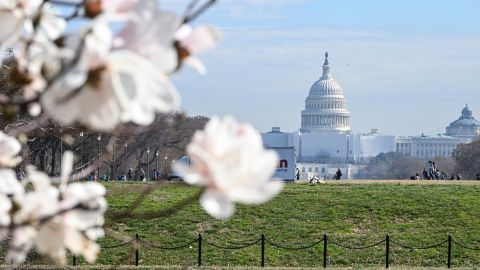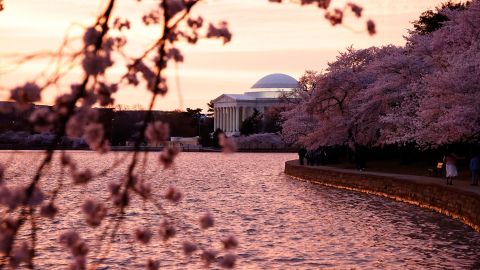CNN
—
Tucked among the thousands of iconic Yoshino cherry trees at the Tidal Basin in Washington, DC, is the “indicator tree,” which erupts into full bloom as much as 10 days earlier than its neighbors and gives officials at the National Park Service a good idea when the rest of them might begin to flower.
This year the indicator tree already started budding — the first stage of the bloom cycle — in the middle of February. That can only mean one thing: Spring (and cherry blossom season) is coming early.
Experts said this year could be a record-breaking early bloom, as temperatures soar way above average for February. Over the past century, the historical average peak bloom date at the Tidal Basin has been April 4, but records show it’s been coming earlier than usual in recent decades.
The earliest peak bloom on record was in March 15, 1990. Michael Litterst, communications chief for National Mall and Memorial Parks with the National Park Service, said he believes that date is “certainly in play this year.”
“All indications are it’s going to be earlier than average,” Litterst told CNN. Last year’s peak bloom was March 25. “We’re about a month out from that, but given what we’ve seen so far, and given what the forecast is, I think we’re probably looking at something earlier than that.”
Peak bloom varies each year depending on weather conditions. According to the National Park Service, Yoshino trees usually reach peak bloom between the last week of March and the first week of April. And the blooming period itself could last several days — it all depends on the weather.
But with the rise of planet-warming pollution, temperatures are getting warmer. And warm winters cause plants and trees to blossom early. Several Japanese plum trees, for instance, which are usually the earliest flowering trees, already blossomed around the National Mall in late January.
“Heat is what partially drives trees like that to blossom,” Litterst said. “And when you look at how mild this winter has been, and the fact that we’ve had zero snow or frozen precipitation this year, it’s not a surprise that we’re seeing this.”
Litterst said he has noticed a connection between warmer temperatures and earlier peak bloom. For example, the average annual temperature at the Martin Luther King Memorial and around the Tidal Basin have “increased a statistically significant 2.5 degrees Fahrenheit between 1895 and 2017,” he said.
At the same time that temperatures were warming, peak bloom dates have also been shifting early by approximately six days.
“And not surprisingly, we are seeing people who are coming in earlier in earlier” to see the capital’s iconic cherry blossoms, he added.

It’s not just Washington, DC. Spring leaf out — when the first tiny leaves emerge from buds of plants that are dormant in the winter — is already the earliest on record in parts of the Southeast, southern Midwest, and Mid-Atlantic, according to the National Phenology Network.
Even New York City is seeing spring leaf out 32 days earlier than normal.
“Spring is coming early in much of the Southern and Eastern US,” Brad Rippey, meteorologist with the US Department of Agriculture, previously told CNN. “Here in the mid-Atlantic, that means everything from budding trees to crocuses in bloom to spring peepers making lots of noise — and in February, no less.”
Many plant species beyond cherry blossoms — including daffodils, witch-hazel and forsythia — are beginning to leaf out in the East. Theresa Crimmins, director of the USA National Phenology Network, said it’s the plants responding to very early warm temperatures.
“Plants, especially those of temperate systems, respond to a number of cues in order to wake up in the spring, including exposure to chill in the winter, exposure to warmth in the spring, and day length,” she told CNN.
But given the recent erratic changes in weather patterns, it’s possible for temperatures to shift again.
According to the National Park Service, cool and calm weather typically extends the length of the bloom, while a rainy and windy day can bring an abrupt end to the ephemeral blossoms.
And a late frost can stop the trees from blooming at all.
This means if another cold snap occurs after this early warm spell, Crimmins said it could be disruptive and damaging for the plants’ cycle. As flower buds develop, many species lose their ability to tolerate cold temperatures, which means a freeze could kill blooms and leave fruit crops and other commodities vulnerable to spring freezes.

Rippey said warm winters followed by a spring freeze have become more common in recent years. In 2017, for instance, a severe spring freeze in March damaged several fruit crops — peaches, blueberries, apples and strawberries — in states including Georgia and South Carolina, which carried an economic toll of roughly $1.2 billion.
“As nice as it feels to have temperatures in the 70s and 80s this time of year, the fact that it’s not ‘normal’ can have a profound impact on the ecosystem,” Rippey said. “Even a typical spring freeze can damage commercial and back-yard fruit crops that have been pushed into blooming by late-winter warmth.”
The National Park Service’s Litterst said they plan to announce the projected peak bloom date on March 1. For now, it’s probably safe to say you can move up your DC cherry blossom picture-taking plans.